Assessing Water Use Efficiency and Stress in Thailand’s River Basins: Trends, Challenges, and Policy Strategies
Abstract
1. Introduction
2. Study Area and Methods
2.1. Study Area
2.2. Research Framework
- (1)
- Data Collection
- (2)
- Supplementary Data Acquisition
- (3)
- Indicator Computation
- (4)
- Evaluation and Interpretation
2.3. Calculation of Indicators
2.3.1. Calculation of Water Use Efficiency
2.3.2. Calculation of Water Stress
2.4. Data Limitations and Uncertainty Considerations
2.4.1. Gaps in Historical Data
2.4.2. Sectoral Water Use Reporting Issues
2.4.3. Transboundary Water Availability Uncertainty
2.4.4. Environmental Flow Requirement (EFR) Approximation
3. Results and Discussion
3.1. Water Use Efficiency
3.1.1. National-Level Water Use Efficiency
3.1.2. Water Use Efficiency at the River Basin Level
3.2. Water Stress
3.2.1. National-Level Water Stress
3.2.2. Water Stress at River Basin Level
3.3. Water Use Efficiency Versus Water Stress
3.3.1. National-Level Analysis
3.3.2. River Basin-Level Analysis
- Group A: Basins with no water stress
- Group B: Basins with tentative-to-low WS and low WUE
- Group C: Basins with tentative-to-low WS and moderate WUE
- Group D: Basins with high WS and low WUE
3.4. Policy Implications
3.4.1. Targeted Interventions at the Basin Level
3.4.2. Expanding Non-Conventional Water Sources
3.4.3. Strengthening Data Collection and Monitoring
3.4.4. Climate Adaptation in Water Resource Management
3.5. Implementation Roadmap
4. Conclusions
Author Contributions
Funding
Institutional Review Board Statement
Informed Consent Statement
Data Availability Statement
Acknowledgments
Conflicts of Interest
References
- Babel, M.S.; Chapagain, K.; Shinde, V.R.; Prajamwong, S.; Apipattanavis, S. A disaggregated assessment of national water security: An application to the river basins in Thailand. J. Environ. Manag. 2022, 321, 115974. [Google Scholar] [CrossRef] [PubMed]
- Liu, W.; Wang, Y.; Huang, J.; Zhu, W. Assessment on the sustainability of water resources utilization in Central Asia based on water resources carrying capacity. J. Geogr. Sci. 2023, 33, 1967–1988. [Google Scholar] [CrossRef]
- Mueller, S.A.; Carlile, A.; Bras, B.; Niemann, T.A.; Rokosz, S.M.; McKenzie, H.L.; Kim, H.C.; Wallington, T.J. Requirements for water assessment tools: An automotive industry perspective. Water Resour. Ind. 2015, 9, 30–44. [Google Scholar] [CrossRef]
- Musie, W.; Gonfa, G. Fresh water resource, scarcity, water salinity challenges and possible remedies: A review. Heliyon 2023, 9, e18685. [Google Scholar] [CrossRef] [PubMed]
- Huang, Z.; Yuan, X.; Liu, X. The key drivers for the changes in global water scarcity: Water withdrawal versus water availability. J. Hydrol. 2021, 601, 126658. [Google Scholar] [CrossRef]
- Kanchanapiya, P.; Tantisattayakul, T. Wastewater reclamation trends in Thailand. Water Sci. Technol. 2022, 86, 2878–2911. [Google Scholar] [CrossRef] [PubMed]
- United Nations. Transforming Our World: The 2030 Agenda for Sustainable Development; UN: New York, NY, USA, 2015; Available online: https://daccess-ods.un.org/access.nsf/Get?OpenAgent&DS=A/RES/70/1&Lang=E (accessed on 19 September 2023).
- Vanham, D.; Hoekstra, A.Y.; Wada, Y.; Bouraoui, F.; De Roo, A.; Mekonnen, M.M.; Van De Bund, W.J.; Batelaan, O.; Pavelic, P.; Bastiaanssen, W.G.M.; et al. Physical water scarcity metrics for monitoring progress towards SDG target 6.4: An evaluation of indicator 6.4.2 “Level of water stress”. Sci. Total Environ. 2018, 613–614, 218–232. [Google Scholar] [CrossRef] [PubMed]
- FAO; UN-Water. Global Status and Acceleration Needs for SDG Indicator 6.4.2. Progress on Level of Water Stress; FAO: Rome, Italy, 2021. [Google Scholar] [CrossRef]
- Callejas Moncaleano, D.C.; Pande, S.; Rietveld, L. Water Use Efficiency: A Review of Contextual and Behavioral Factors. Front. Water 2021, 3, 685650. [Google Scholar] [CrossRef]
- Giupponi, C.; Gain, A.K.; Farinosi, F. Spatial assessment of water use efficiency (SDG Indicator 6.4.1) for regional policy support. Front. Environ. Sci. 2018, 6, 141. [Google Scholar] [CrossRef]
- Doeffinger, T.; Hall, J.W. Water Stress and Productivity: An Empirical Analysis of Trends and Drivers. Water Resour. Res. 2020, 56, e2019WR025925. [Google Scholar] [CrossRef]
- Galli, A.; Đurović, G.; Hanscom, L.; Knežević, J. Think globally, act locally: Implementing the sustainable development goals in Montenegro. Environ. Sci. Policy 2018, 84, 159–169. [Google Scholar] [CrossRef]
- Krantz, V.; Gustafsson, S. Localizing the sustainable development goals through an integrated approach in municipalities: Early experiences from a Swedish forerunner. J. Environ. Plan. Manag. 2021, 64, 2641–2660. [Google Scholar] [CrossRef]
- OECD. Multi-Dimensional Review of Thailand (Volume 2): In-Depth Analysis and Recommendations; OECD Development Pathways; OECD Publishing: Paris, France, 2019. [Google Scholar] [CrossRef]
- Eckstein, D.; Künzel, V.; Schäfer, L. Global Climate Risk Index 2021: Who Suffers Most from Extreme Weather Events? Weather-Related Loss Events in 2019 and 2000 to 2019; Germanwatch: Bonn, Germany, 2021; Available online: https://www.germanwatch.org/en/node/19777 (accessed on 8 September 2023).
- Hellegers, P.; Van Halsema, G. SDG indicator 6.4.1 “change in water use efficiency over time”: Methodological flaws and suggestions for improvement. Sci. Total Environ. 2021, 801, 149431. [Google Scholar] [CrossRef] [PubMed]
- Thai Meteorological Department. Annual Mean Rainfall in Thailand (mm) 30 Years. Available online: https://www.tmd.go.th/en/ClimateChart/annual-mean-rainfall-in-thailand-mm-30-years (accessed on 9 April 2023).
- Saeed, F.H.; Al-Khafaji, M.S.; Al-Faraj, F.A.M.; Uzomah, V. Sustainable Adaptation Plan in Response to Climate Change and Population Growth in the Iraqi Part of Tigris River Basin. Sustainability 2024, 16, 2676. [Google Scholar] [CrossRef]
- Bilalova, S.; Newig, J.; Tremblay-Lévesque, L.-C.; Roux, J.; Herron, C.; Crane, S. Pathways to water sustainability? A global study assessing the benefits of integrated water resources management. J. Environ. Manag. 2023, 343, 118179. [Google Scholar] [CrossRef] [PubMed]
- MRC. Agreement on the Cooperation for the Sustainable Development of the Mekong River Basin; Walter de Gruyter: Vientiane, Laos, 1995. [Google Scholar]
- GEMI. Step-by-Step Monitoring Methodology for SDG Indicator 6.4.1; Integrated Monitoring Initiative for SDG 6, Version 20 ed.; FAO: Rome, Italy, 2019. [Google Scholar]
- GEMI. Step-by-Step Methodology for Monitoring Water Stress (6.4.2); Integrated Monitoring Initiative for SDG 6, Version 4 ed.; FAO: Rome, Italy, 2019. [Google Scholar]
- United Nations. International Standard Industrial Classification of All Economic Activities. Statistical Papers, Revision 4 ed.; UN: New York, NY, USA, 2008. [Google Scholar]
- FAO; UN-Water. Progress on Change in Water-Use Efficiency. Global Status and Acceleration Needs for SDG Indicator 6.4.1, 2021; FAO: Rome, Italy, 2021. [Google Scholar] [CrossRef]
- UN-Water. SDG 6 Data Portal. Available online: https://www.unwater.org/our-work/sdg-6-data-portal (accessed on 8 September 2023).
- Sachs, J.D.; Lafortune, G.; Fuller, G.; Drumm, E. Implementing the SDG Stimulus. Sustainable Development Report 2023; Dublin University Press: Dublin, Ireland, 2023. [Google Scholar]
- Abhishek; Kinouchi, T.; Sayama, T. A comprehensive assessment of water storage dynamics and hydroclimatic extremes in the Chao Phraya River Basin during 2002–2020. J. Hydrol. 2021, 603, 126868. [Google Scholar] [CrossRef]
- Vanham, D.; Mekonnen, M.M. The scarcity-weighted water footprint provides unreliable water sustainability scoring. Sci. Total Environ. 2021, 756, 143992. [Google Scholar] [CrossRef] [PubMed]

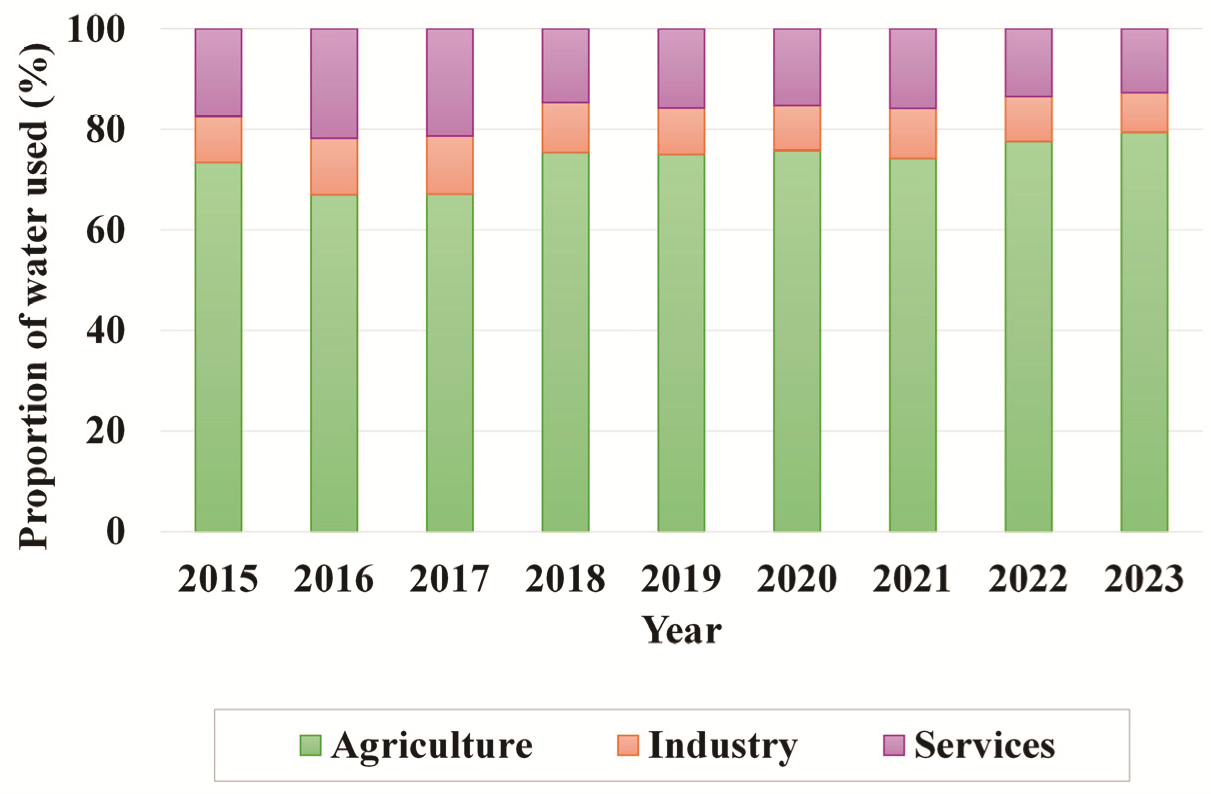
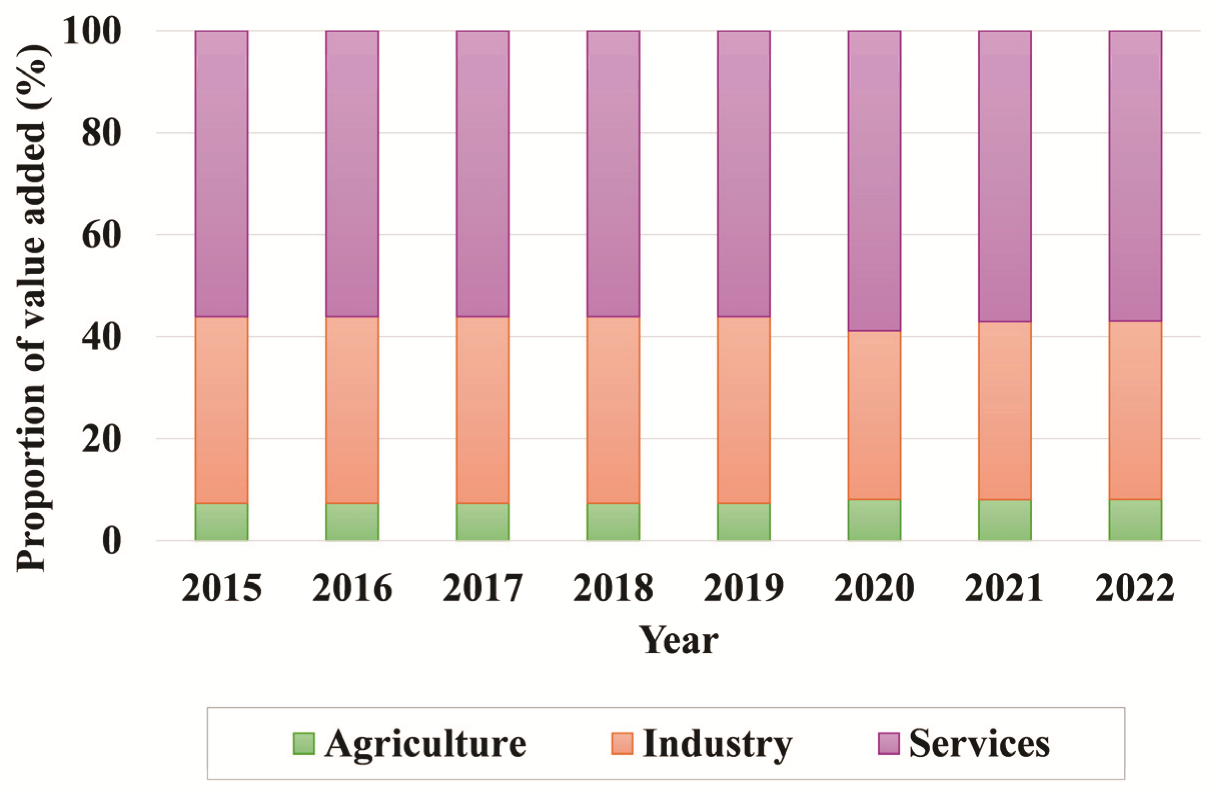

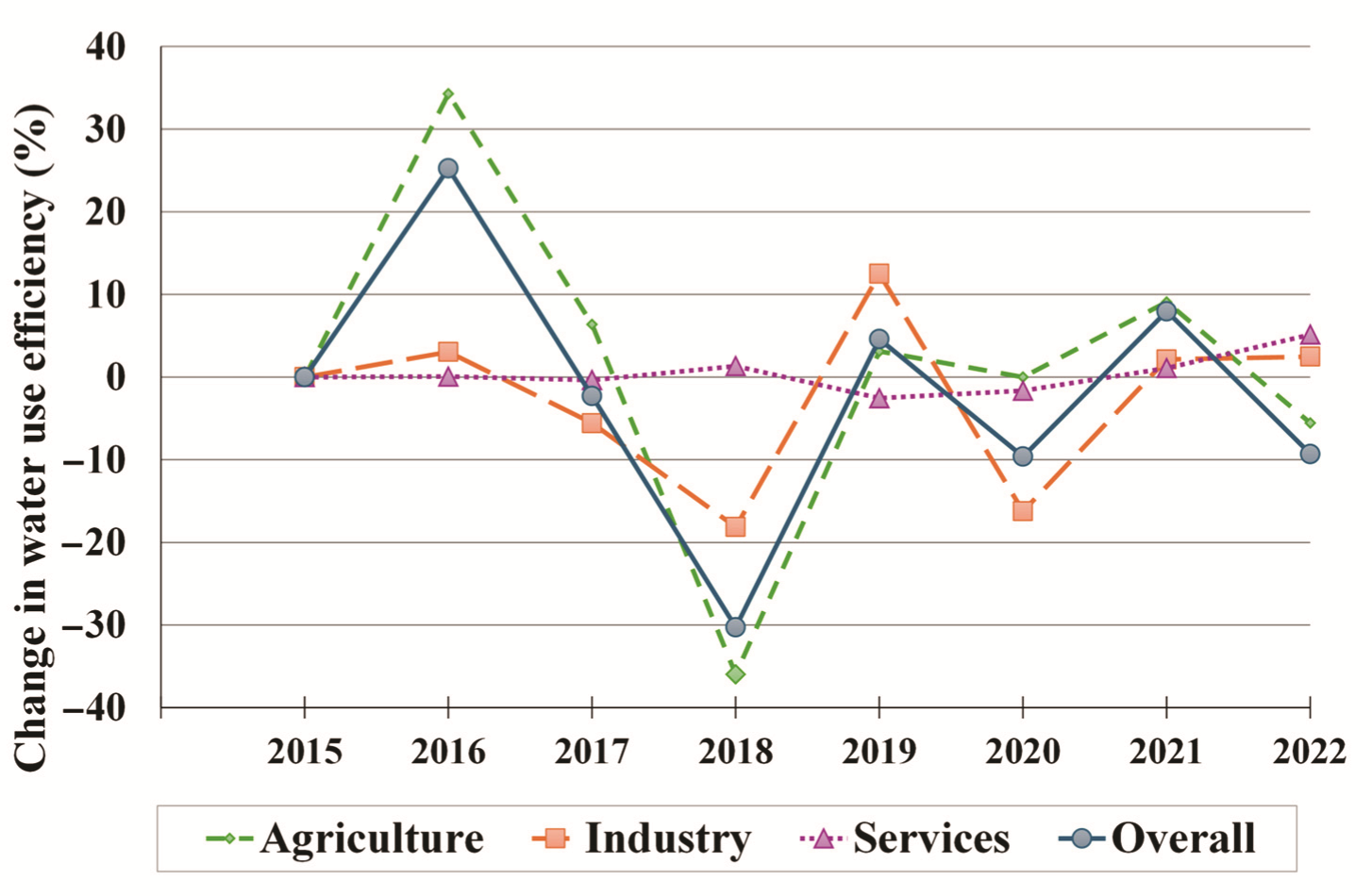
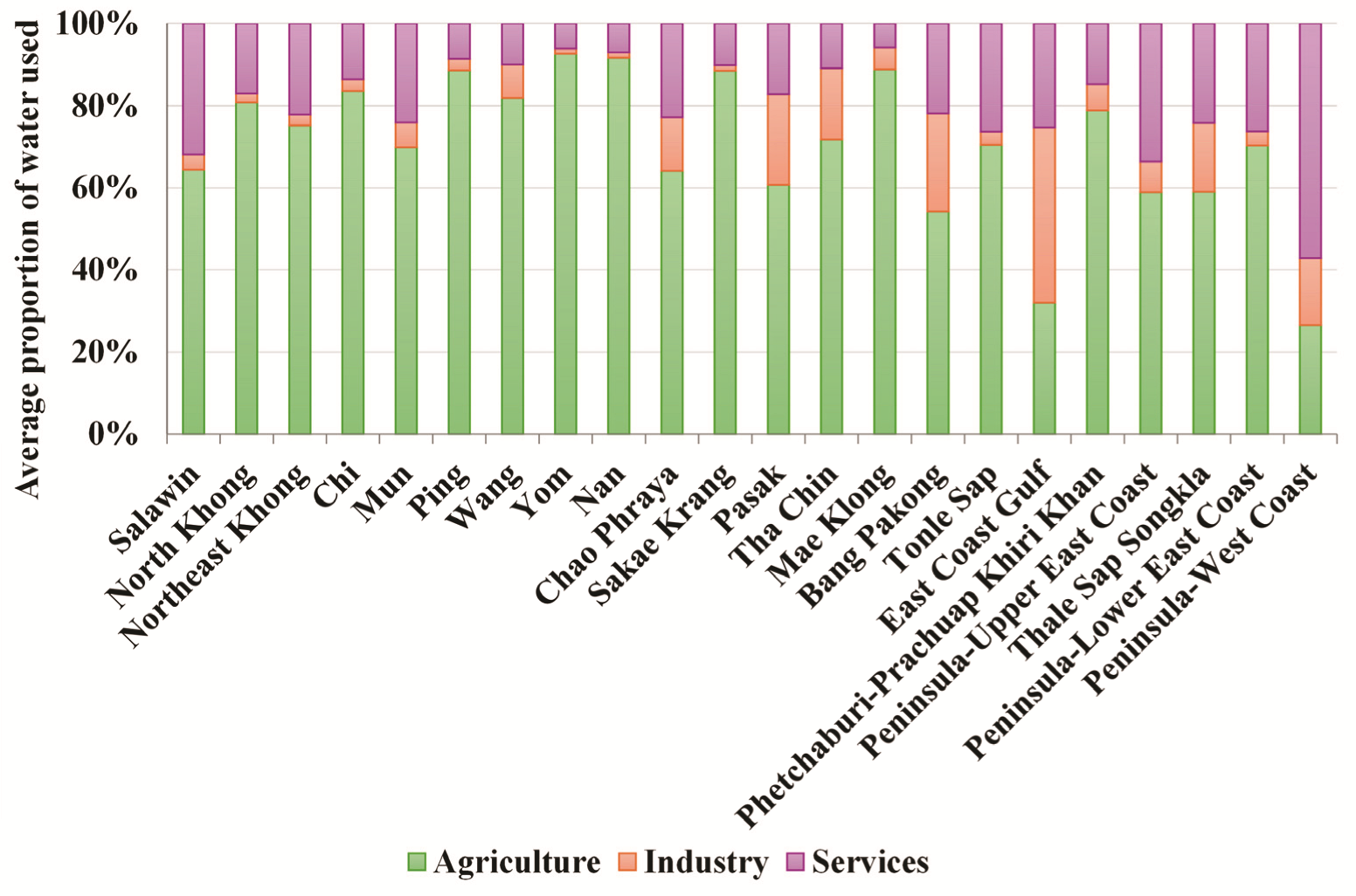



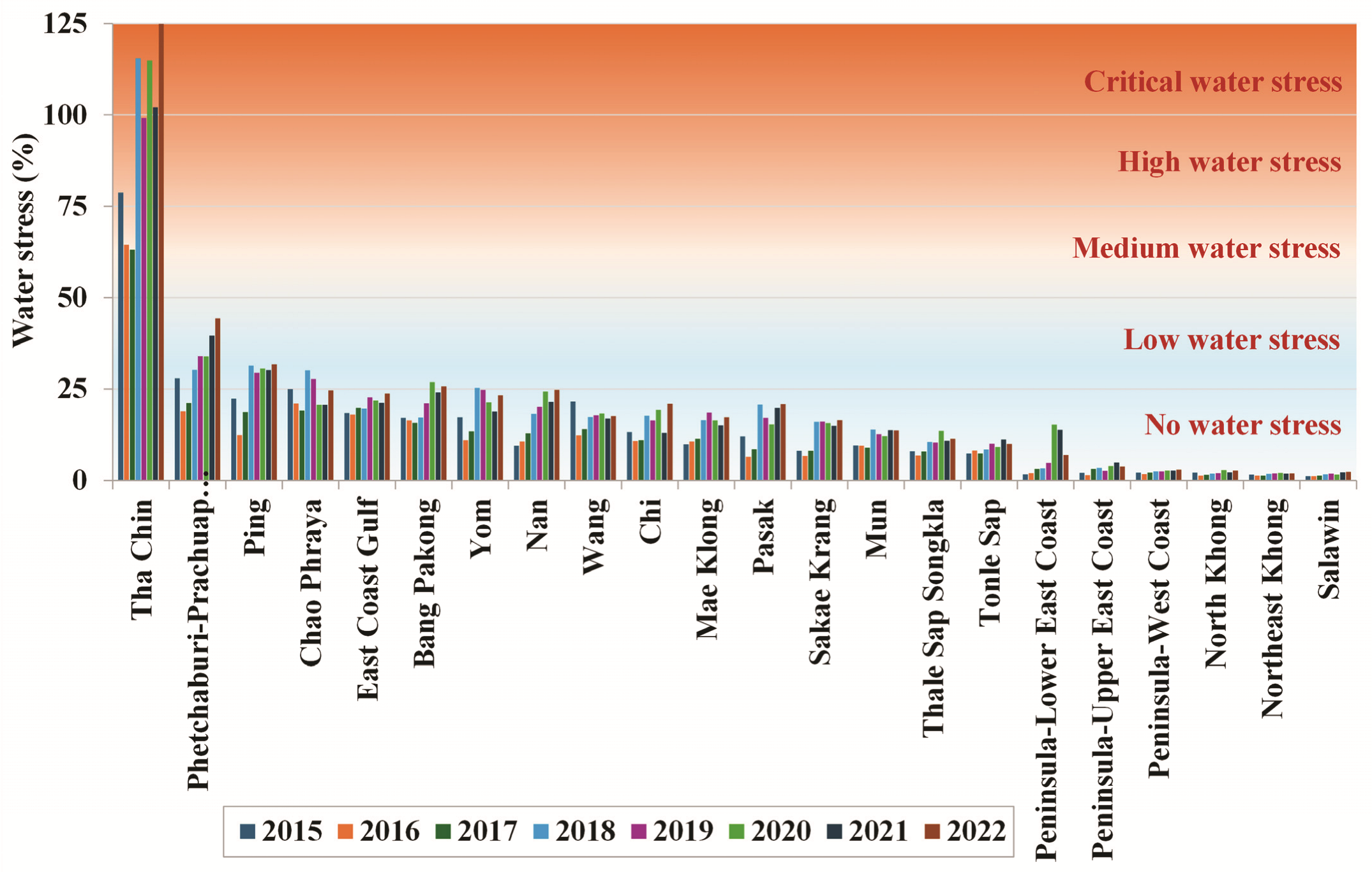
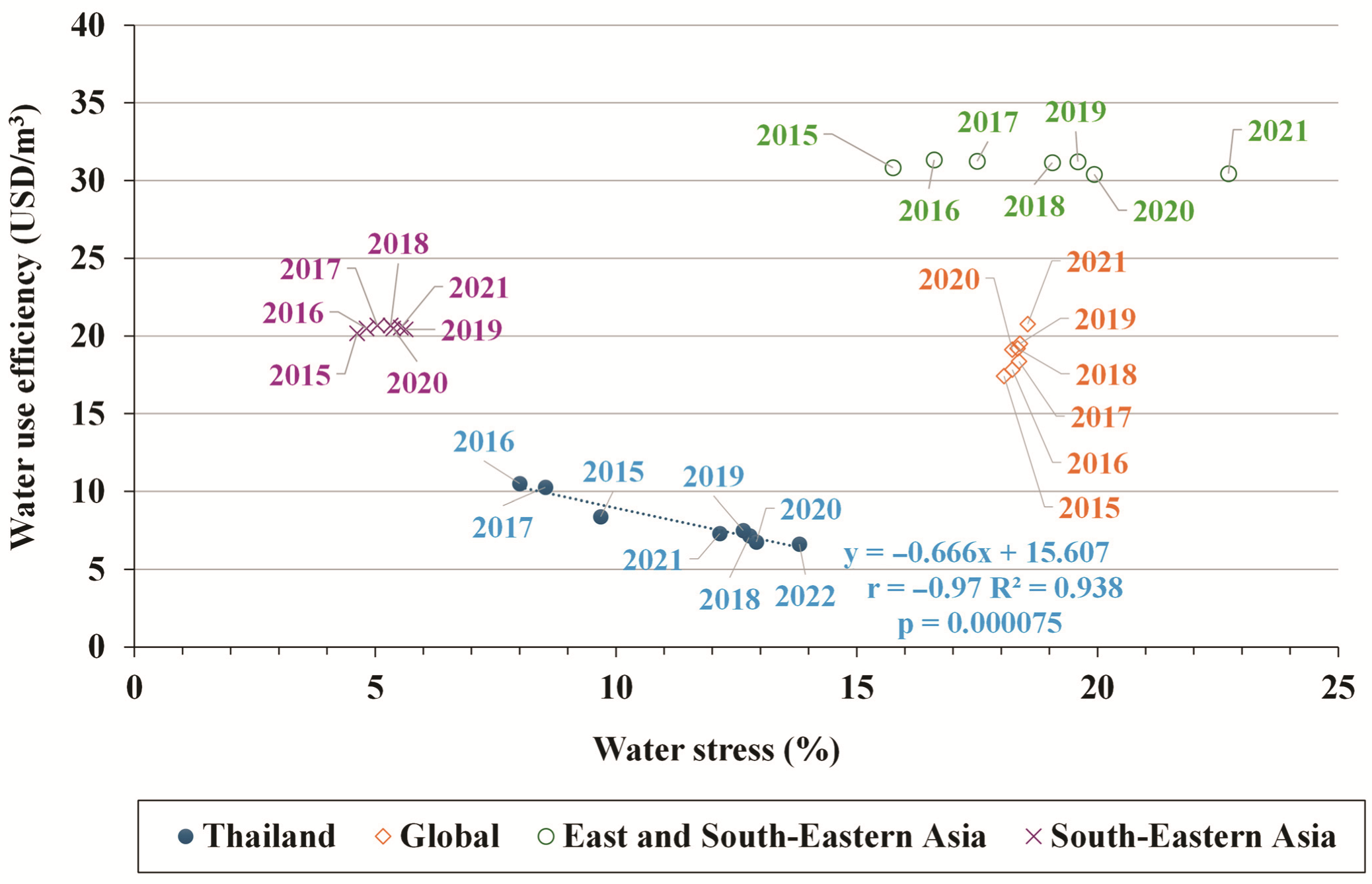
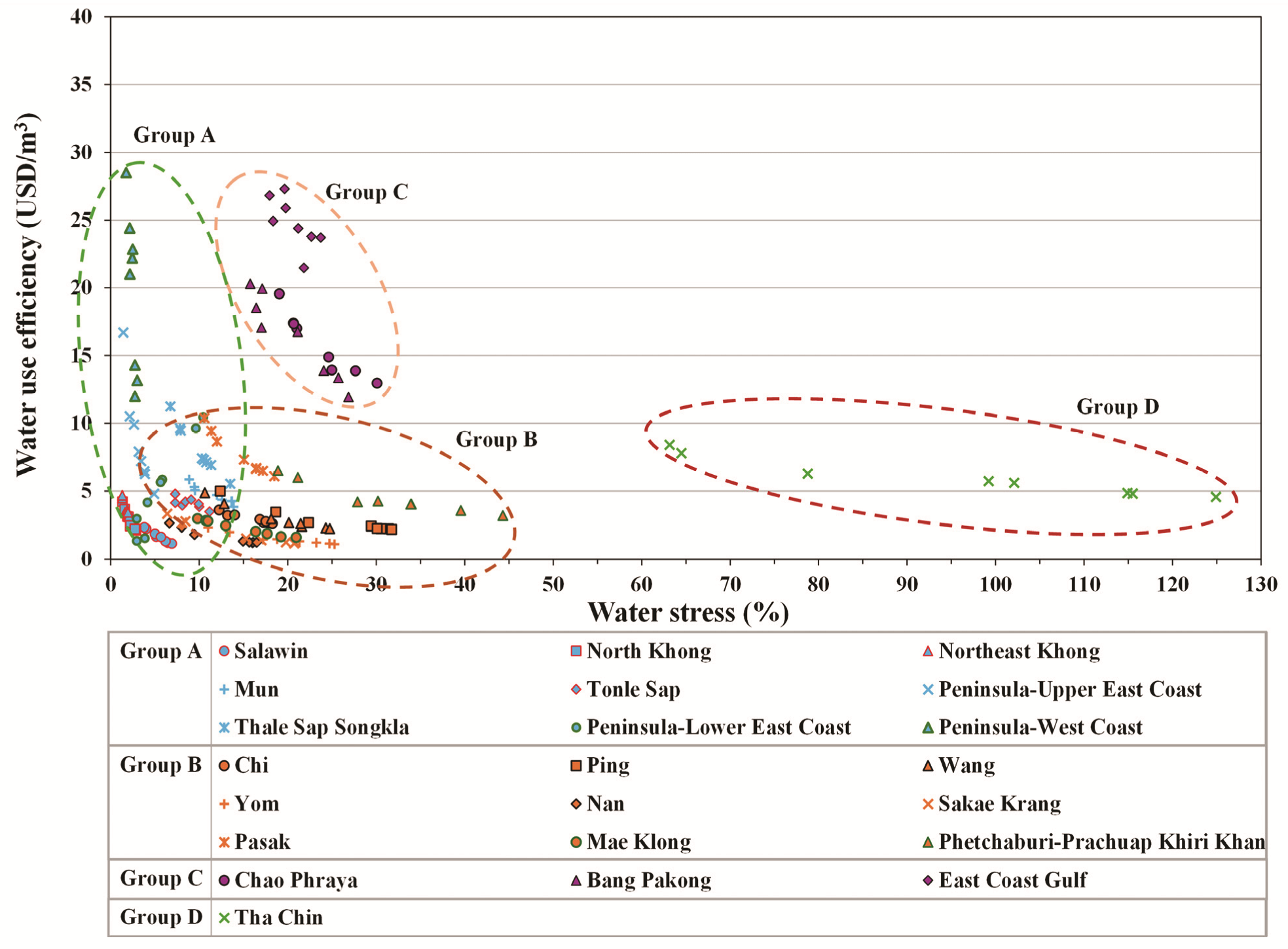
| Agriculture | Industry | Services |
|---|---|---|
Water for irrigated cultivation
Water for freshwater aquaculture | Water for manufacturing
Water used for construction | Water produced by the Metropolitan Waterworks Authority Water produced by the Provincial Waterworks Authority Water produced by a large municipality Village waterworks Domestic (household) use * (e.g., drinking, sanitation, personal use) |
| Year | Thailand * | Global * | ||||||
|---|---|---|---|---|---|---|---|---|
| Awe | Mwe | Swe | WUE | Awe | Mwe | Swe | WUE | |
| 2015 | 0.35 | 34.72 | 28.36 | 8.39 | 0.50 | 28.42 | 104.39 | 17.42 |
| 2016 | 0.47 | 35.78 | 28.38 | 10.51 | 0.52 | 28.95 | 103.66 | 17.83 |
| 2017 | 0.50 | 33.79 | 28.28 | 10.27 | 0.53 | 30.35 | 105.83 | 18.37 |
| 2018 | 0.32 | 27.66 | 28.66 | 7.16 | 0.55 | 32.58 | 108.44 | 19.19 |
| 2019 | 0.33 | 31.12 | 27.93 | 7.49 | 0.57 | 33.27 | 108.71 | 19.51 |
| 2020 | 0.33 | 26.07 | 27.47 | 6.77 | 0.62 | 32.86 | 104.25 | 19.12 |
| 2021 | 0.36 | 26.63 | 27.77 | 7.31 | 0.67 | 37.16 | 111.01 | 20.77 |
| 2022 | 0.34 | 27.29 | 29.20 | 6.63 | 0.57 | 31.94 | 106.61 | 18.89 |
| Average | 0.38 | 30.38 | 28.26 | 8.07 | 0.57 | 31.94 | 106.61 | 18.89 |
| Change, 2015–2022 | −2.9% | −21.4% | 3.0% | −21.0% | 14.0% | 12.4% | 2.1% | 8.4% |
| Basin Name | Pa (%) | Pm (%) | Ps (%) | Awe (USD/m3) | Mwe (USD/m3) | Swe (USD/m3) | WUE (USD/m3) | |
|---|---|---|---|---|---|---|---|---|
| 1 | Salawin | 64.4 | 3.7 | 31.9 | 0.3 | 48.8 | 10.5 | 5.4 |
| 2 | North Khong | 80.7 | 2.2 | 17.0 | 0.3 | 22.9 | 13.0 | 2.9 |
| 3 | Northeast Khong | 75.2 | 2.7 | 22.1 | 0.3 | 31.7 | 11.7 | 3.7 |
| 4 | Chi | 83.5 | 2.9 | 13.6 | 0.2 | 40.0 | 12.1 | 3.0 |
| 5 | Mun | 69.9 | 5.9 | 24.2 | 0.4 | 24.5 | 12.3 | 4.7 |
| 6 | Ping | 88.6 | 2.7 | 8.6 | 0.7 | 33.2 | 15.2 | 2.8 |
| 7 | Wang | 81.9 | 8.1 | 10.0 | 0.6 | 14.8 | 13.4 | 3.0 |
| 8 | Yom | 92.6 | 1.2 | 6.2 | 0.3 | 21.9 | 15.1 | 1.5 |
| 9 | Nan | 91.7 | 1.3 | 7.0 | 0.2 | 30.3 | 15.0 | 1.6 |
| 10 | Chao Phraya | 64.1 | 13.1 | 22.9 | 0.3 | 26.9 | 53.5 | 15.9 |
| 11 | Sakae Krang | 88.5 | 1.3 | 10.1 | 0.3 | 21.2 | 13.4 | 1.9 |
| 12 | Pasak | 60.7 | 22.0 | 17.3 | 1.0 | 19.6 | 16.0 | 7.7 |
| 13 | Tha Chin | 71.7 | 17.5 | 10.8 | 0.3 | 21.7 | 18.0 | 6.0 |
| 14 | Mae Klong | 88.8 | 5.3 | 5.9 | 0.4 | 17.8 | 16.9 | 2.3 |
| 15 | Bang Pakong | 54.2 | 24.0 | 21.8 | 0.5 | 39.0 | 31.5 | 16.5 |
| 16 | Tonle Sap | 70.5 | 3.1 | 26.4 | 0.9 | 25.6 | 10.4 | 4.1 |
| 17 | East Coast Gulf | 32.0 | 42.6 | 25.4 | 0.8 | 41.5 | 27.1 | 24.8 |
| 18 | Phetchaburi–Prachuap Khiri Khan | 78.9 | 6.3 | 14.8 | 0.9 | 24.0 | 15.1 | 4.5 |
| 19 | Peninsula–Upper East Coast | 58.9 | 7.4 | 33.7 | 1.0 | 27.8 | 18.0 | 8.7 |
| 20 | Thale Sap Songkla | 61.4 | 15.7 | 22.9 | 0.9 | 20.2 | 17.2 | 8.1 |
| 21 | Peninsula–Lower East Coast | 70.3 | 3.3 | 26.3 | 0.8 | 28.3 | 13.9 | 5.2 |
| 22 | Peninsula–West Coast | 26.5 | 16.4 | 57.1 | 1.4 | 18.3 | 28.4 | 19.8 |
| Year | 2015 | 2016 | 2017 | 2018 | 2019 | 2020 | 2021 | 2022 | 2023 |
|---|---|---|---|---|---|---|---|---|---|
| Thailand WS (%) | 9.7 | 8.0 | 8.5 | 12.8 | 12.6 | 12.9 | 12.2 | 13.8 | 14.7 |
| Global WS * (%) | 18.1 | 18.2 | 18.4 | 18.3 | 18.4 | 18.2 | 18.6 | - | - |
| Policy Area | Action Needed | Responsible Entity | Priority |
|---|---|---|---|
| Basin-Level Management | Implement stricter water allocation policies in high-stress basins (Tha Chin, Chao Phraya). | ONWR, River Basin Committee | High—urgent (short-term) |
| Efficient Water Use in Agriculture | Promote drip irrigation, precision farming, and crop selection based on water availability. | Ministry of Agriculture and Cooperatives | High—large impact, moderate feasibility (medium-term) |
| Industrial Water Efficiency | Enforce water recycling and closed-loop systems in manufacturing. | Ministry of Industry, Industrial Estate Authority of Thailand | Medium—high impact, requires regulation enforcement (medium-term) |
| Wastewater Reuse and Desalination | Expand treated wastewater use in industrial and urban areas. | Local Governments, Public Utilities, Industrial Zones | Medium—scalable, moderate cost (medium- to long-term) |
| Climate Adaptation in Water Planning | Invest in drought-resilient infrastructure and integrate seasonal forecasts. | Meteorological Department, Ministry of Natural Resources & Environment | Low—high investment, long-term implementation (long-term) |
Disclaimer/Publisher’s Note: The statements, opinions and data contained in all publications are solely those of the individual author(s) and contributor(s) and not of MDPI and/or the editor(s). MDPI and/or the editor(s) disclaim responsibility for any injury to people or property resulting from any ideas, methods, instructions or products referred to in the content. |
© 2025 by the authors. Licensee MDPI, Basel, Switzerland. This article is an open access article distributed under the terms and conditions of the Creative Commons Attribution (CC BY) license (https://creativecommons.org/licenses/by/4.0/).
Share and Cite
Thepprasit, C.; Sukrakanchana, B.; Sa-nguanduan, N. Assessing Water Use Efficiency and Stress in Thailand’s River Basins: Trends, Challenges, and Policy Strategies. Sustainability 2025, 17, 4477. https://doi.org/10.3390/su17104477
Thepprasit C, Sukrakanchana B, Sa-nguanduan N. Assessing Water Use Efficiency and Stress in Thailand’s River Basins: Trends, Challenges, and Policy Strategies. Sustainability. 2025; 17(10):4477. https://doi.org/10.3390/su17104477
Chicago/Turabian StyleThepprasit, Chaiyapong, Bawornrat Sukrakanchana, and Nitirach Sa-nguanduan. 2025. "Assessing Water Use Efficiency and Stress in Thailand’s River Basins: Trends, Challenges, and Policy Strategies" Sustainability 17, no. 10: 4477. https://doi.org/10.3390/su17104477
APA StyleThepprasit, C., Sukrakanchana, B., & Sa-nguanduan, N. (2025). Assessing Water Use Efficiency and Stress in Thailand’s River Basins: Trends, Challenges, and Policy Strategies. Sustainability, 17(10), 4477. https://doi.org/10.3390/su17104477






